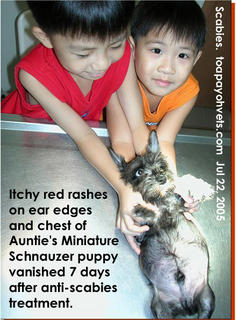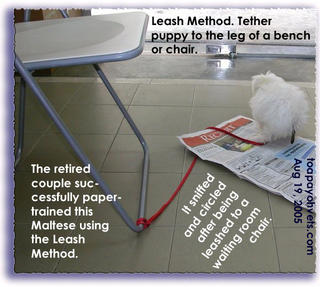Toilet Training Your First Puppy in SingaporePaper-training and other methods
1. In Singapore, paper-training is the most common method recommended by the puppy sellers. This is because over 80% of the people live in apartments. However, the puppy sellers seldom have time to give detailed toilet-training instructions. The employees may not have the depth of knowledge and give advices according to the life-style and situations in the residence. Couples without children would need advices different from families with many children. Older parents may or may not sabotage the toilet-training instructions.
In all cases, the new owner needs to spend time to supervise and bring the puppy to the toilet. It does not know where the toilet is.
2. TOILET TRAINING in the dog is also known as house-training or house-breaking.
2.1 EVERY HOUR, ON THE HOUR. If your puppy is around 8 weeks old, you need to take the puppy to the toilet every hour, on the hour.
2.2 When the puppy is about to squat, say "Pee now". When it obliges, give it a treat and praise. Let it play for 15 minutes under supervision. Put it back into the crate.
3. If you don't have a crate, the substitutes are
playpen (puppy pen), leash it to your waist, tether it to a table near you.
4. In addition, take it to the toilet whenever it wakes up from a nap, finishes playing, eats or look restless (sniffing the floor, circling).
5. As the puppy gets older, extend the one hour to more than one hour. As a general guideline,
a 2-month old puppy can hold its bladder for 2 hours and a 3-month-old puppy can hold its bladder for 3 hours. But this is a guideline.
NIGHT TIME.
6. Put the puppy in a crate if you have one. It is an invaluable aid to toilet-training (house training). Put the crate in your bedroom. She whines when she wants to go to the toilet. You need to get up to bring her to the toilet. If not, you weaken the "clean den" instinct in which all puppies do not soil their sleeping area which is the crate.
7. After taking it out, put it right back in the crate. No cuddling or it will wake you up for cuddling.
8. By 12 weeks, most pups sleep through the night. Continue to crate it at night till it is at least one year old.
9. When there is an accident, don't punish the puppy by rubbing its nose into the urine or beating it. Say "Go toilet" and bring it to the toilet spot. Then clean the tiles thoroughly with an anti-ammonia cleaner.
10. FEEDING TIME. In Singapore, pet shop operators are the main source of puppies for sale. They usually sell puppies from 8 weeks old. They often recommend puppies be fed two times per day. This is because many puppy owners are working and the puppies are home alone. Most puppy books and humane organisations recommend three times a day.
The two times per day feeding schedule appears to be satisfactory for most puppies. Smaller ones like the chihuahua and mini-Maltese may need 3 times per day.
Take away the food within 15 minutes if the puppy does not finish eating. This prevents finickiness in eating, lets the owner know that the puppy is sick (no appetitie) and aids in toilet training. Puppies usually pass motion within 1 hour after eating. So, owners can paper-train them easier if they know how to do so.
11. WATER. Water is usually given through a water bottle although there are some concerns from the humane shelter that the water may not be easily accessed by the puppy. Water given in water bowls get spilled or wet some mischievious puppies, hence the water bottle is a practical recommendation for such puppies. To aid in toilet training, stop giving water after dinner.
SOME REASONS FOR FAILURE TO TOILET-TRAIN1.
Owners work. . Nobody has time or knowledge on how to toilet train the new puppy.
1.1
Playpen + crate. Ideally, confine the puppy in a playpen (4-6 pieces of fences) large enough to accommodate a
crate. Crates are referred to as
cage by some locals. Make sure that the puppy pen will not collapse on the puppy while you are not at home. Put a thick pad of newspapers on the floor. Leave your puppy and its crate (with the door open) inside the pen. Most puppies will learn to pass urine and stools at one area of the newspaper and will not soil her crate (sleeping area). However, many puppies will shred the newspapers. Provide chew toys with food inside.
When you go home, just change the newspapers without making a fuss or punish the puppy. This is seldom recommended by the pet shop operators as the cost is much higher. They recommend the playpen.
2.
Paper Shredding in the playpen.In Singapore, most first-time owners buy 4 pieces of fences to hook together to form a playpen. The apartment may also be too small for a bigger playpen. Put newspapers to cover 100% of the floor. Note the area which the puppy soils. Usually it is a particular spot. Every day, reduce the paper covering the floor by 10%. The puppy will be paper-trained when it uses the soils newspapers only.
3.
Urine spray aid from the pet shop.Commercial toilet training pads from the pet shop.
Puppy gate to confine the puppy in the balcony area.
Wire or obstacle to prevent the puppy leaving a confined area.
When proper paper trained, let the puppy have a bigger area to move. Lift up the playpen so that it can access the newspaper when it needs to go to the toilet. Or open up the fences of the playpen.
If you can't supervise for signs of restlessness, accidents will happen. Just clean up the soiled area with an anti-ammonial floor cleaner.
4.
Paper shredding. This is the most common complaint. Just ignore the puppy while you clear the mess on returning home from work. If you use puppy training pads, shredding may be costly but they are more absorbent of the urine and keep the feet clean unlike black feet from newspapers. There are pee-trays clipping the pads or some pads have stickers to stick them onto the floor.
5.
Traces of urine on tiled floors. Use a commercial
anti-ammonial floor cleaner. Purchase from a pet shop. Or use vinegar (1 part of vinegar to 3 parts of water). If the puppy still goes to that particular spot, you may not have cleaned thoroughly. For resistant cases, spray an insect repellant on the area or use perfume to discourage the puppy.
6.
Medical problems. Urinary tract infection may not be possible for the puppy to hold its urine. Consult your veterinarian. Skin problems. Diarrhoea and vomiting episodes all delay the toilet-training of the puppy. However, daily training still has to be done as the older the puppy, the harder to toilet-train.

7.
Change of toilet area. If the older puppy is used to the carpet, paper-trained or the pee tray, it will hold its bladder if you want it to go to the grass downstairs. Bring pieces of carpet or paper with you and gradually reduce the pieces so that the puppy will eliminate on the grass.
8.
Far away from the toilet area. The pup cannot hold too long if the toilet is far away. If you want it to go to the grass downstairs, do it promptly after eating. At night, the apartment may need a dimmer light for the new puppy to locate its toilet if it is left to wander at home.
9. Consider litterbox training. Commercially available pelleted litter for dogs.
10. Older dog. Some puppies go to the same toilet area as the older dog, but some don't know what to do.
If you have no time for the puppy or don't know what to do, it is best to
read, research on the internet or consult your friends or veterinarian.
SHARING YOUR INSIGHTS: READERS e-mail to me your problems or solutions.
Your queries may be included in the book to help all puppy owners all over the world. E-mail to judy@toapayohvets.com
SPONSORS NEEDED:Advertisers and sponsors for this book and another book HOW YOUR PUPPY CAN LIVE LONGER?, please e-mail to judy@toapayohvets.com for more info or tel: +65 9668-6468.












